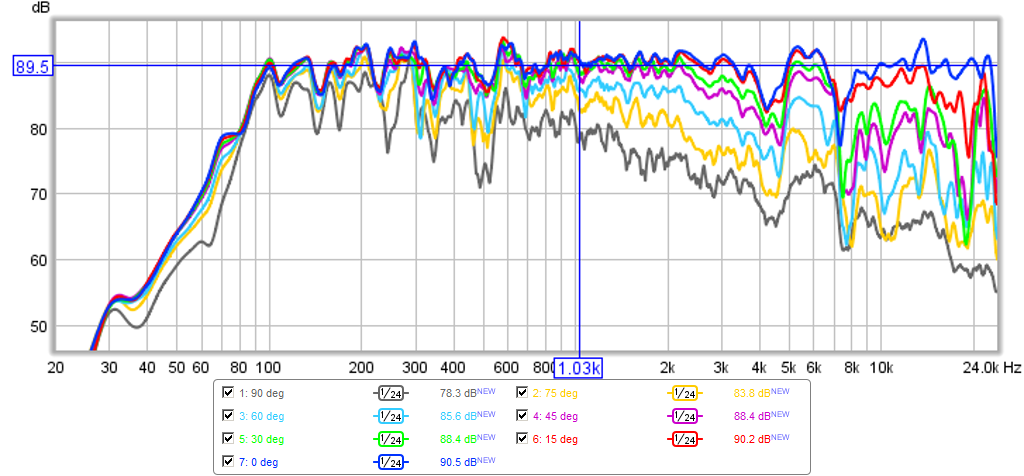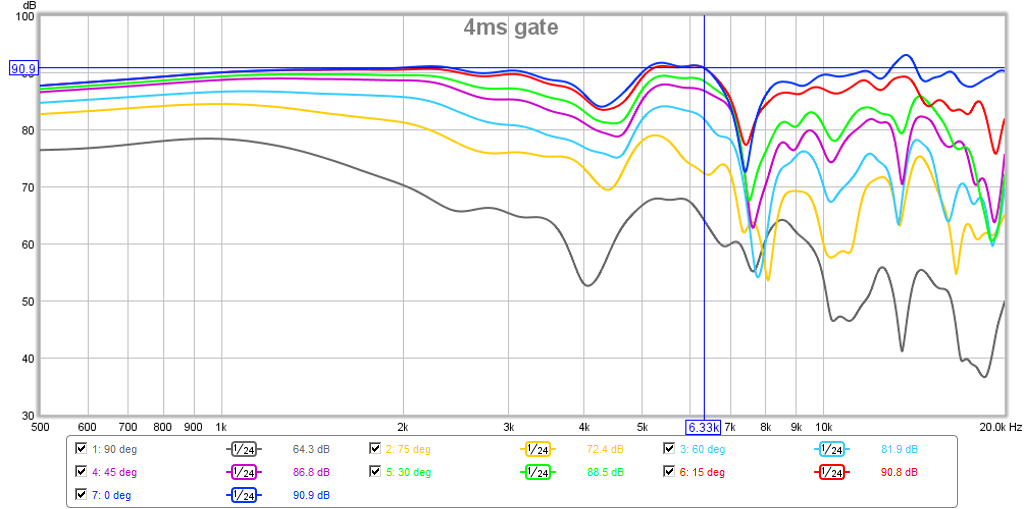Argh ! Why have we not in France a Part Express with so cheap drivers as the 8 polycones ? Whyyyyyyyyyy ?
Argh ! Why have we not in France a Part Express with so cheap drivers as the 8 polycones ? Whyyyyyyyyyy ?
Qnty 8 x 6.5in polycones that I used or cheap 8 in polycones?
Titan 8" Treated Paper Cone Foam Surround Woofer 8 Ohm
I did not use these but they look like they have a decent motor, 88dB, Qts 0.35:
HP-6020 6-1/2" Poly Cone Woofer with Rubber Surround 8 Ohm
Yes, the cheap 8x6.5" for the trynergy build: one polycone is a price here of a 12 cl glass of wine in a wine bar !
Never saw a so damned good price for a driver, I ask a green card for Santa !
!
Never saw a so damned good price for a driver, I ask a green card for Santa
 !
!The mic was 0.5m away and +15 deg above horizontal plane. Data is over 90 deg half angle. First plot is un-gated, second is 4ms gated to remove room reflections. The throat notch anomaly carries through for all angles, the variation between angles appears smooth. The core beam width appears pretty uniform over 60deg full angle and directional below that. I am not sure what I can measure to show that there is directivity at 100Hz over a plain direct radiator.
Un-gated:

4ms Gate:

Exellent thanks. Yes it is clear how directional this speaker is, just what I'm looking for!
Question the response on axis (15 degrees up) seems not very flat. I am trying to compare different frequency graphs on this thread. And I'm not sure what to take away from it all. Is the response fairly flat on axis? Are those dips or throat notches as you called them because the mic is 15 degrees up? Sorry for my confusion.
Question the response on axis (15 degrees up) seems not very flat. I am trying to compare different frequency graphs on this thread. And I'm not sure what to take away from it all. Is the response fairly flat on axis? Are those dips or throat notches as you called them because the mic is 15 degrees up? Sorry for my confusion.
No, the notches are due to the finite width of the cone and the throat width. Sound waves from one edge of the cone will destructively interfere with sound waves from the other edge. This is why phase plugs are important - they prevent this self cancellation due to non-point source radiators. 7.5kHz corrresponds to a half-wave distance of 0.9in wall to radiator, or about the middle of the cone to the throat edge for a 2in x 2in throat.
It is pretty uniform up and down over 30 deg. So being off 15 deg is about at the edge. I had it there by accident thinking it was level - tricky because the speaker as mounted tilts up.
Last edited:
Nice T-Shirt X 😀 your design skills spread wide.
Think bwaslo pointed out that Rephase can help simplify setup and probably improve performance further, for those setups add a badge on the sleeve saying "Rephase"
Think bwaslo pointed out that Rephase can help simplify setup and probably improve performance further, for those setups add a badge on the sleeve saying "Rephase"
Will the model be delivering the t-shirts?
Only if you order qnty 1000 shirts. 🙂
I bought 2 Visatons FRS 8M.
What formula should i follow to determine back chamber volume?
I have read Edgar's midbass horn PDF, there is a formula that, when simulated with 12" driver for a midbass gave perfect response in Hornresp.
I wonder how you determined the back chamber volume.
What formula should i follow to determine back chamber volume?
I have read Edgar's midbass horn PDF, there is a formula that, when simulated with 12" driver for a midbass gave perfect response in Hornresp.
I wonder how you determined the back chamber volume.
Only if you order qnty 1000 shirts. 🙂
Too late, I ordered 2 000 when she said she has a sister !
Btw there is an error on the upper shematic : it lackes two big toroid transformers (sorry, my french !) !
I bought 2 Visatons FRS 8M.
What formula should i follow to determine back chamber volume?
I have read Edgar's midbass horn PDF, there is a formula that, when simulated with 12" driver for a midbass gave perfect response in Hornresp.
I wonder how you determined the back chamber volume.
In the akabak sim I pick a practical volume - as small as possible. It will be related to Vas of driver and probably around same as Vas or half of Vas. It's not that critical. Make sure it is lined with foam and well stuffed to absorb back wave.
What are the vas (or datas) advised in your design if we are looking for equivalent drivers in this part of the world instead the 8 x 6.5" polycone drivers ?
For me, I picked the $5 woofers because it's what I had on hand and needed 8 of them. It may not be the ideal driver. They are rather high Qts and high Vas so not ideal. It depends on if you want to make a large enclosure that surrounds the whole horn, then you can pick drivers with larger Vas. If on a budget, find whatever you can get and look for higher Qts if xmax is small so you can reach 80Hz to 100Hz easily without EQ. If drivers have lots of xmax and moderate to low Qts, then that can work. Best thing is to simulate it with the script I provided to be sure. But if shopping for cheap drivers, look for minimum 3mm xmax, ideally 5mm. Qts in 0.55 to ~1. Vas in the 10 to 30 liter range.
Look for something similar to these:
GRS 6PF-8 6-1/2" Paper Cone Foam Surround Woofer
TC-6028 6-1/2" Treated Paper Cone Woofer with Foam Surround 8 Ohm
Here is a Visaton that may be available in Europe (only 2mm xmax though):
Visaton W170-8 6.5" Woofer 8 Ohm
This one is available in Europe for 17 Euro: http://www.lautsprechershop.de/index_chassis_en.htm?chassis/main_en.htm
Look for something similar to these:
GRS 6PF-8 6-1/2" Paper Cone Foam Surround Woofer
TC-6028 6-1/2" Treated Paper Cone Woofer with Foam Surround 8 Ohm
Here is a Visaton that may be available in Europe (only 2mm xmax though):
Visaton W170-8 6.5" Woofer 8 Ohm
This one is available in Europe for 17 Euro: http://www.lautsprechershop.de/index_chassis_en.htm?chassis/main_en.htm
Last edited:
Thanks X,
With the datas, it's possible to find some cheap equivalent to the polycones here !
I haven't been starting some room measurement yet, but I have ! and also on the actual speaker ! Between the Stereophile measurement and the same speaker in my room : I wil see the main peaks and dips above 125 Hz and can abstract some simple behaviors...
With the datas, it's possible to find some cheap equivalent to the polycones here !
I haven't been starting some room measurement yet, but I have ! and also on the actual speaker ! Between the Stereophile measurement and the same speaker in my room : I wil see the main peaks and dips above 125 Hz and can abstract some simple behaviors...
Last edited:
Heeeeelp
I dug out my 7.1 RCA out soundcard (Asus Xonar Essence) and I think I can save myself a few bucks from getting a MiniDSP. Question is how do I use 7.1 soundcard as crossover? Can it be used with REW?
I dug out my 7.1 RCA out soundcard (Asus Xonar Essence) and I think I can save myself a few bucks from getting a MiniDSP. Question is how do I use 7.1 soundcard as crossover? Can it be used with REW?
That's a nice sound card. Get Jriver and there are EQ plugins as well as LP, HP digital plugins. Set those for your preferred slope etc. There is also a delay plugin. This solution is actually better than a miniDSP. I don't have one but have heard good things about it from others. I think Byrtt may be able to give you assistance on how to get it working in Jriver. It will cost you $50 for Jriver so you save some money but you have 8 channels out and it's very flexible and more powerful.
Yes you can. If you want more DSP power than what a MiniDSP can deliver look into JRiver. Combined with that 8 channel card (I have it myself, the Essence ST + add on) you can do a lot of neat things.
JRiver can be downloaded and used as a 30 day trail. Be prepared to buy it though, it's hard to let go again. You could probably get away with using Foobar and some plugins.
But I love JRiver's convenience and also use it's movie features with the awesome madVR video renderer. I've been using it from version 17 when I took the trail. I don't upgrade each year but certainly every other year. One of the best investments I made.
Edit: X beat me to the punch 😀
JRiver can be downloaded and used as a 30 day trail. Be prepared to buy it though, it's hard to let go again. You could probably get away with using Foobar and some plugins.
But I love JRiver's convenience and also use it's movie features with the awesome madVR video renderer. I've been using it from version 17 when I took the trail. I don't upgrade each year but certainly every other year. One of the best investments I made.
Edit: X beat me to the punch 😀
Right on, that makes two bits of good news today. My parts express order has also arrived at the cross border depot. My very first order and it's 10 drivers haha! I'm exited and will probably hop in the car pretty soon and go for a little drive to the U.S. of A.
Things are coming along. 😉
Thanks for the constant support all. It's really something great.
Shawn
Things are coming along. 😉
Thanks for the constant support all. It's really something great.
Shawn
Heeeeelp.....
Don't be sorry having a miniDSP on steroids ...😀
Example if you want DAC's up the system controlled bandwidth player can run 192kHz downstream all plugins and deliver that digital stream bit-perfect (WASAPI/ASIO) direct into Burr-Browns.
Also good pocket thing one license covers use 2x computer, look forward follow your winter project, feel free ask to computer setup when time comes.
- Home
- Loudspeakers
- Multi-Way
- Presenting the Trynergy - a full range tractrix synergy.
